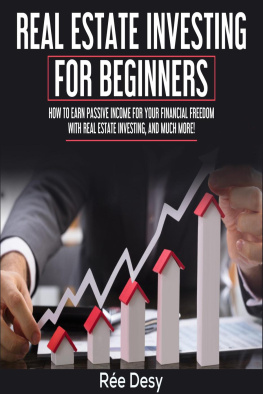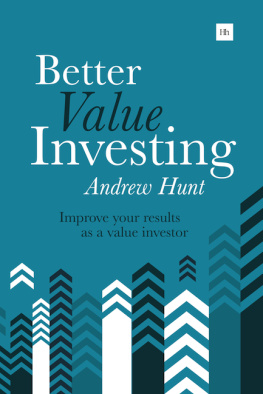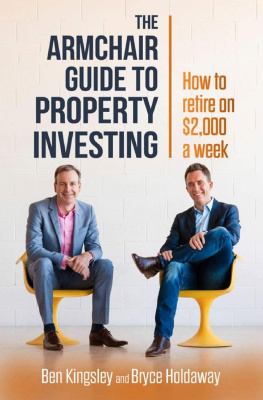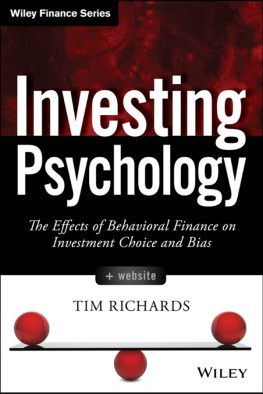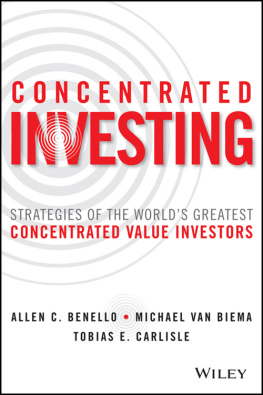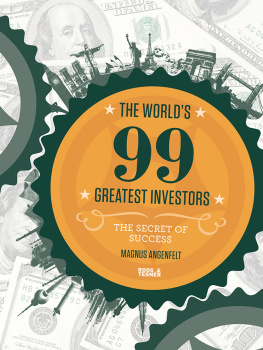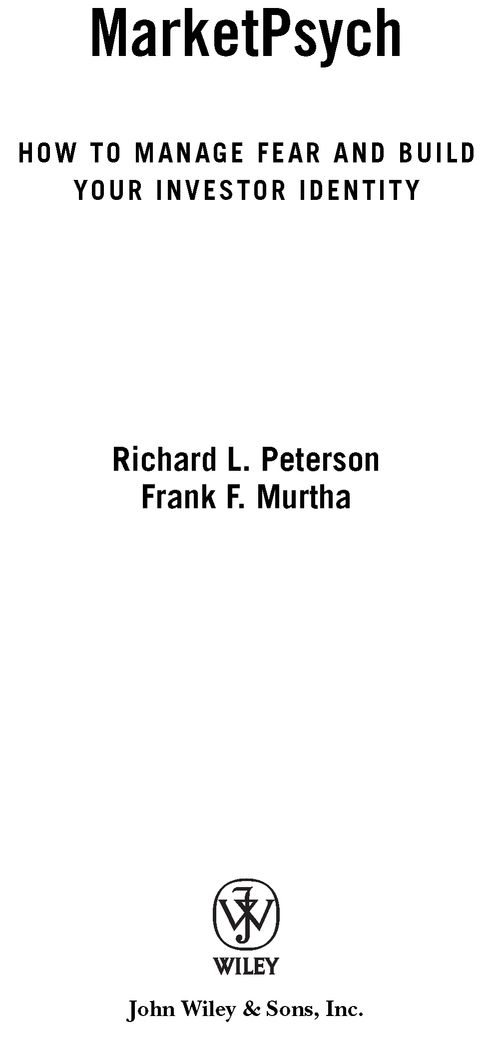Table of Contents
For Sarah, Lucia, and Aurora. You are such a joy!
Richard
For Lillian. Thanks for keeping me on the path.
Frank
Preface
You may not realize it but you are on a dangerous journeythe life-long process of wealth accumulation. Your destination is to establish financial freedom and security so that you (and your loved ones) can enjoy the quality of life you have always wanted. But make no mistake, you have an enemy that doesnt want you to get there. The enemy is the market, and it is engaged in a covert psychological war designed to subvert you at every opportunity. The market probes for emotional weak spots and exploits them, scaring you out when the worst is over, luring you in when the gains have been made, baiting you into chasing fools gold, or convincing you to it s okay to perpetually start tomorrow.
Sure, the journey seems easy enough. Buy low, sell high, and all that. The market goes up over time. Just put your money away, and youll get to where you want to go. If only it were that easy. Investing in the market more closely resembles a crooked carnival game in which you throw a softball at a stack of milk bottles for a dollar. Its so easy! So simple, a child could do it. Step right up! The deception is the simplicity. The game is designed for you to lose.
Dont believe us? From 1989 through 2008, the S&P 500 Index had a 5.51 percent average annual return after inflation. Looks fine, you say. But what did the average equities investor get as an average annual return, postinflation, during that same 20-year period? Negative 0.97 percent per year. (We told you the market was out to get you.) Those are percentages. What about real-life dollars?
A market return on $100,000 invested in the U.S. stock market in January of 1989 would yield a postinflation total of $292,329 20 years laternearly three times as much. Yet the average equities investor would have a total of $82,288 after the same time period. These two returns represent the difference between Ivy League universities for your kids or state schools, between a down payment on a house or not, between vacationing or staying home. In short, this is the difference between leading the life you want to live, and leading the life youre forced to live.
Losses are not only possible, theyre predictable. Its the way the game is designed. At the carnival, they get you with physicsthe milk bottles are spread out so that it is virtually impossible for a softball to knock them all down with one throw. The market gets you with psychology, baiting you into a reactive paradigm that turns your own fear, greed, hope, and even pride against you. After several go-rounds we find ourselves asking, wheres my 9 percent average annual return? And how come I never knock down all the milk bottles?
The investing process even preys on our own biology. The rational, reasoning part of our brainthe prefrontal cortexevolved about 100,000 years ago. It grew on top of the deep brain centers that manage emotion and motivation (the limbic system). In general, the evolution of the prefrontal cortex is an excellent thingits essentially what makes us human. The problem is that the prefrontal cortex evolved after the limbic system, and thus while it sits on top of the limbic system and manages and directs our impulses, it can be knocked offline by surges of emotion courtesy of you-know-who.
That is why we wrote this book: to destroy this myth, reset the rules of the game, and to arm and train you for the psychological battle. It all starts with the recognition of a truth that we call the fundamental premise: Investing success appears to be about the market, but its not; its about you. The market will do what it has always donego up, go down, and try to throw you off like a rider on a mechanical bull. The only question that matters is, what will you do? Here is where our focus needs to be, on what we can control. And this book outlines what those things are and what it takes to master them.
We know that some of the concepts along the way may be counterintuitive. Thats why everything in this book is backed up by scientific research in the fields of neuroscience, behavioral finance, and clinical psychology.
Who is this book for? Its for you. You have hopes and desires for a better life for you and the people you care about. And you invest your moneyor shouldso that you can achieve this better life. Whether you are a first-time investor who is just beginning the process or a seasoned professional looking to optimize performance, the key to success remains the samemanaging emotions and establishing what we call an investor identity. This book serves as a guide for doing just that. It uses a number of different techniques including case studies, exercises, and questionnaires/self-assessments along the way so you can relate these concepts specifically to yourself and begin building the skills to use them.
Chapter 1 gives an overview of the relationship between psychology and investing and provides a context for the book. It also introduces the concept of an investor identity and why it is crucial for long-term investing success.
Chapter 2 lays out the fundamentals of an investor identity. It addresses where to start (what we call frames), and the five questions to ask before investing. Unfortunately, in taking these first steps many investors start out on the wrong foot, ensuring problems ahead. The chapter goes on to uncover the real and hidden motivations that underlie our investing decisions, another crucial component of your investor identity. The chapter concludes with a section on goal-setting, outlining a technique we call the Slide Show Method that keeps investors focused on what they want their investing to achieve.
Chapter 3 digs into the concept of your investor personality. It breaks your particular personality down into the Big Five traits associated with both investing success and vulnerability. It details how you can identify these traits in yourself and work with them. This chapter also addresses the genetic components that contribute to your investing style.
Chapter 4 is about recognizing the role emotions play in your investing decisions. Most people recognize that investing is an emotional process. What they often fail to appreciate is the extent to which these emotions are hidden, even from ourselves. This chapter addresses how these unconscious emotions often subvert our attempts to make good choices with our moneyand what we can do to gain control over them.
Chapter 5 addresses your investing values. In particular, it goes into the root causes of the what, how, and why of your biggest investment beliefs and the ways they affect your choicesfor good or ill. This chapter also helps you identify ways you can play to your investing strengths by investing in a way that is in keeping with your values and interests. Last, it addresses financial traumas and what they do to our investing identity going forward.
Chapter 6 addresses your blind spots. It details a number of the most common (and nastiest) traps and how and why investors fall into them. This chapter also contains checklists so you can evaluate your personal susceptibility to these problems and outlines steps you can use to free yourself and avoid them in the future. It concludes with a set of investing archetypes based on recognizable characters.



